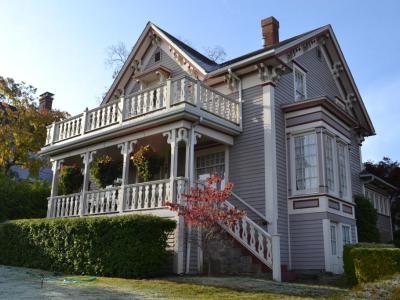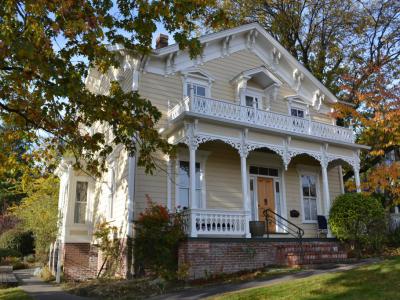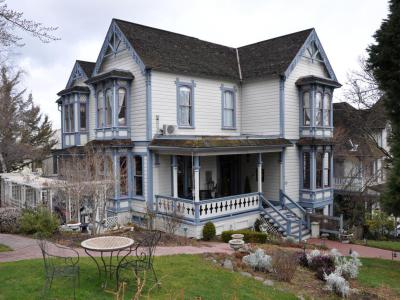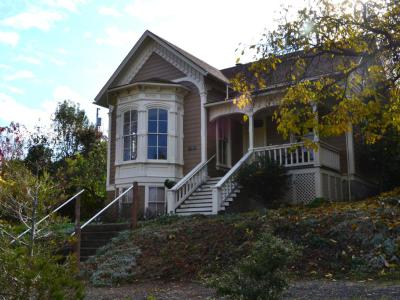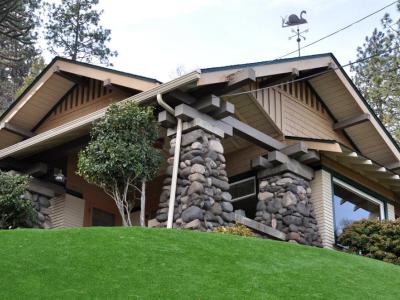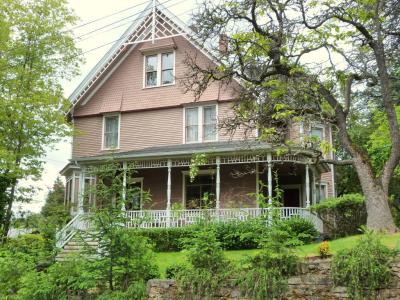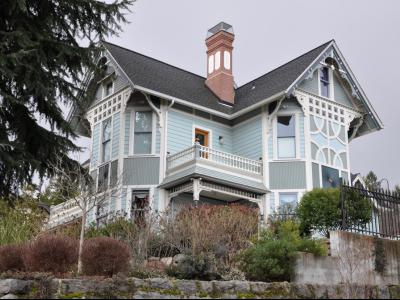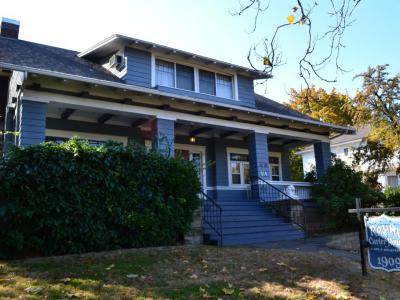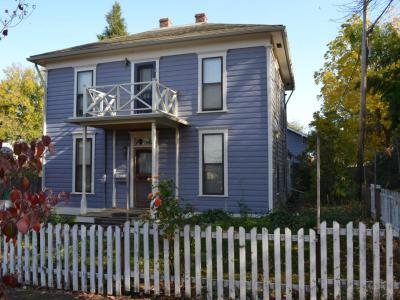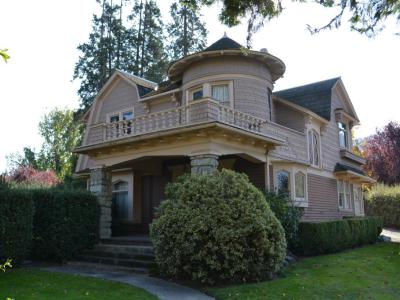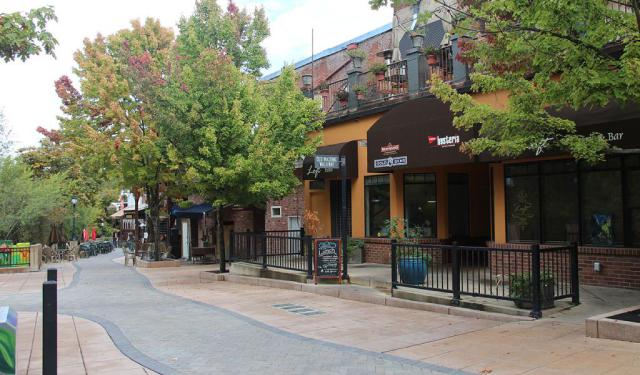
Ashland Historical Houses Walking Tour (Self Guided), Ashland
From graceful Victorian-era residences to imposing public edifices, the architectural marvels in Ashland provide insight into the city's development over the years. Downtown Ashland is marked by traditional architecture, set within a quaint valley, that retains an overarching rural ambiance. Boasting a plethora of old dwellings, it represents a remarkable example of exceptional preservation and historical significance, reflecting distinctive architectural styles and enduring presence amidst changing times.
One notable residence here is the Coolidge House, known for its Victorian charm and intricate detailing. Similarly, the Isaac Woolen House stands as a testament to the craftsmanship of its time, with its eye-catching facade. The Atkinson House exudes elegance with its Italianate design, while the Fordyce Roper House captivates visitors with its unique blend of architectural influences.
Meanwhile, the Baldwin Beach House, crafted by the entrepreneurial spirit of Baldwin Beach, epitomizes his innovative approach to architecture and serves as a tangible testament to his enduring legacy in shaping the evolution of Ashland.
Moving forward, the Boslough-Claycomb House and the Eddings-Provost House present a contrast in architectural styles, showcasing the progression of design. The Carter House and the Carter-Fortmiller House, both created by architect Frank Chamberlain Clark, stand as some of Ashland's premier historic properties, exemplifying the Arts and Crafts tradition and the Bungalow style respectively.
The Nils Ahlstrom House and the Barclay-Klum House highlight the diversity of architectural heritage in the area, with the former reflecting Ashland's railroad history and the latter standing as a remarkable suburban Queen Anne cottage.
Finally, the George Taverner House is a cherished landmark exemplifying the elegance of the early 20th-century era and embodying the collaborative efforts of Taverner and Clark architects in forming Ashland's cultural landscape.
As custodians of architectural and historical legacy, it is our responsibility to preserve and celebrate iconic landmarks for future generations. Our self-guided tour is one of the ways to engage with these treasures and ensure their continued relevance in the fabric of Ashland. Join us in honoring the city's history and visit these remarkable houses to become part of their today's story!
One notable residence here is the Coolidge House, known for its Victorian charm and intricate detailing. Similarly, the Isaac Woolen House stands as a testament to the craftsmanship of its time, with its eye-catching facade. The Atkinson House exudes elegance with its Italianate design, while the Fordyce Roper House captivates visitors with its unique blend of architectural influences.
Meanwhile, the Baldwin Beach House, crafted by the entrepreneurial spirit of Baldwin Beach, epitomizes his innovative approach to architecture and serves as a tangible testament to his enduring legacy in shaping the evolution of Ashland.
Moving forward, the Boslough-Claycomb House and the Eddings-Provost House present a contrast in architectural styles, showcasing the progression of design. The Carter House and the Carter-Fortmiller House, both created by architect Frank Chamberlain Clark, stand as some of Ashland's premier historic properties, exemplifying the Arts and Crafts tradition and the Bungalow style respectively.
The Nils Ahlstrom House and the Barclay-Klum House highlight the diversity of architectural heritage in the area, with the former reflecting Ashland's railroad history and the latter standing as a remarkable suburban Queen Anne cottage.
Finally, the George Taverner House is a cherished landmark exemplifying the elegance of the early 20th-century era and embodying the collaborative efforts of Taverner and Clark architects in forming Ashland's cultural landscape.
As custodians of architectural and historical legacy, it is our responsibility to preserve and celebrate iconic landmarks for future generations. Our self-guided tour is one of the ways to engage with these treasures and ensure their continued relevance in the fabric of Ashland. Join us in honoring the city's history and visit these remarkable houses to become part of their today's story!
How it works: Download the app "GPSmyCity: Walks in 1K+ Cities" from Apple App Store or Google Play Store to your mobile phone or tablet. The app turns your mobile device into a personal tour guide and its built-in GPS navigation functions guide you from one tour stop to next. The app works offline, so no data plan is needed when traveling abroad.
Ashland Historical Houses Walking Tour Map
Guide Name: Ashland Historical Houses Walking Tour
Guide Location: USA » Ashland (See other walking tours in Ashland)
Guide Type: Self-guided Walking Tour (Sightseeing)
# of Attractions: 12
Tour Duration: 2 Hour(s)
Travel Distance: 3.8 Km or 2.4 Miles
Author: nataly
Sight(s) Featured in This Guide:
Guide Location: USA » Ashland (See other walking tours in Ashland)
Guide Type: Self-guided Walking Tour (Sightseeing)
# of Attractions: 12
Tour Duration: 2 Hour(s)
Travel Distance: 3.8 Km or 2.4 Miles
Author: nataly
Sight(s) Featured in This Guide:
- Coolidge House
- Isaac Woolen House
- Atkinson House
- Fordyce Roper House
- Baldwin Beach House
- Boslough-Claycomb House
- Eddings-Provost House
- Carter House
- Carter-Fortmiller House
- Nils Ahlstrom House
- Barclay-Klum House
- George Taverner House
1) Coolidge House
The Coolidge House stands as a testament to the Victorian era's elegance and charm. Built in 1875 by Orlando Coolidge, the first nurseryman in the area, this romantic Italianate home overlooks North Main Street, near the bustling downtown plaza. With over 130 years of history, the Coolidge House has been lovingly preserved and transformed into a bed and breakfast, inviting guests to experience its timeless allure.
Stepping into the Coolidge House, guests are greeted by a sense of elegance and refinement that harkens back to a bygone era. The interior exudes Victorian charm, with spacious suites and a separate cottage offering a tranquil retreat for visitors. Each suite is meticulously appointed with thoughtful touches, ensuring a comfortable and memorable stay for guests seeking relaxation and rejuvenation.
One of the highlights of a stay at the Coolidge House is the gourmet breakfast served in the dining room or back courtyard, offering a delightful start to the day. Guests can also unwind on the front porch, bask in the serenity of the courtyard, or admire the picturesque views of the town and Cascade mountains from the upper balcony.
Stepping into the Coolidge House, guests are greeted by a sense of elegance and refinement that harkens back to a bygone era. The interior exudes Victorian charm, with spacious suites and a separate cottage offering a tranquil retreat for visitors. Each suite is meticulously appointed with thoughtful touches, ensuring a comfortable and memorable stay for guests seeking relaxation and rejuvenation.
One of the highlights of a stay at the Coolidge House is the gourmet breakfast served in the dining room or back courtyard, offering a delightful start to the day. Guests can also unwind on the front porch, bask in the serenity of the courtyard, or admire the picturesque views of the town and Cascade mountains from the upper balcony.
2) Isaac Woolen House
Constructed in 1876 by architect-builder L. S. P. Marsh, the Isaac Woolen House stands as a historical landmark in Ashland. Marsh, a local lumberman, utilized materials from his planing mill to craft this charming residence, contributing to the architectural landscape of late 19th-century homes in the area. The design of the Isaac Woolen House reflects the prevalent Italianate residential style of the time, evident in its bracketed cornice, ornate bay windows, and intricate roof details that adorn the facade.
Isaac Woolen, the original owner of the house, arrived in Jackson County before 1860 and initially farmed in the Bear Creek Valley before settling in Ashland. In 1878, Woolen became one of the first residents to have water directly piped to his home when a water pipe from the West Ashland Ditch was installed—an essential development in the town's infrastructure. Woolen's significant involvement in the community extended beyond his residency, as he was a charter member of the Ashland Masonic Lodge, established in 1875, reflecting his commitment to the town's social fabric and institutions.
Throughout its history, the Isaac Woolen House has been associated with prominent figures in Ashland's development. Captain Thomas Smith, a respected Jackson County farmer and active politician, acquired the house in 1884. Smith's involvement in local politics and business, including his role in founding the Bank of Ashland, underscores the house's significance during a transformative period in Ashland's evolution from a rural farming center to a thriving business and cultural community.
Isaac Woolen, the original owner of the house, arrived in Jackson County before 1860 and initially farmed in the Bear Creek Valley before settling in Ashland. In 1878, Woolen became one of the first residents to have water directly piped to his home when a water pipe from the West Ashland Ditch was installed—an essential development in the town's infrastructure. Woolen's significant involvement in the community extended beyond his residency, as he was a charter member of the Ashland Masonic Lodge, established in 1875, reflecting his commitment to the town's social fabric and institutions.
Throughout its history, the Isaac Woolen House has been associated with prominent figures in Ashland's development. Captain Thomas Smith, a respected Jackson County farmer and active politician, acquired the house in 1884. Smith's involvement in local politics and business, including his role in founding the Bank of Ashland, underscores the house's significance during a transformative period in Ashland's evolution from a rural farming center to a thriving business and cultural community.
3) Atkinson House
The W. H. Atkinson House stands as a prominent example of the Italian Bracketed or Italianate architectural style, showcasing elaborate decorations and meticulous preservation. Constructed in 1880, the house reflects the vision of W. H. Atkinson, who arrived in Ashland in 1874 and quickly became involved in the town's industrial and banking sectors. Atkinson's entrepreneurial spirit led him to invest in various enterprises, including a share in the Ashland Flour Mill and later partnership in the Ashland Woolen Manufacturing Company. Beyond business, Atkinson played a pivotal role in the community's cultural and social development, contributing to the establishment of the Ashland Library and Reading Room Association and aiding in the founding of the Presbyterian Church.
Situated on a picturesque site that once housed the mansions of prominent Ashland figures Coolidge and Woolen, the Atkinson House embodies Atkinson's aspirations for an elegant and distinguished residence for his family. Construction of the house commenced in August 1880 under Atkinson's direction, reflecting his ambition and vision for the architectural landscape of Ashland.
Despite his untimely death at the age of 50 in 1894, Atkinson's legacy endured through his widow Eugenia, who resided in the house for 24 years after his passing. Eugenia Atkinson continued her husband's legacy of community involvement, contributing funds for the construction of the Atkinson Memorial Bridge over Ashland Creek in Lithia Park, ensuring the family's enduring impact on the town's development.
Situated on a picturesque site that once housed the mansions of prominent Ashland figures Coolidge and Woolen, the Atkinson House embodies Atkinson's aspirations for an elegant and distinguished residence for his family. Construction of the house commenced in August 1880 under Atkinson's direction, reflecting his ambition and vision for the architectural landscape of Ashland.
Despite his untimely death at the age of 50 in 1894, Atkinson's legacy endured through his widow Eugenia, who resided in the house for 24 years after his passing. Eugenia Atkinson continued her husband's legacy of community involvement, contributing funds for the construction of the Atkinson Memorial Bridge over Ashland Creek in Lithia Park, ensuring the family's enduring impact on the town's development.
4) Fordyce Roper House
The Fordyce Roper House, also known as the Southern Oregon Hospital, stands as a testament to Ashland's rich architectural heritage and storied past. Constructed in 1886 on East Main Street, the house was one of twelve fine residences erected that year, boasting the distinction of being the most expensive among them. Originally built for Fordyce and Julia Roper, the house showcases the distinctive characteristics of the Eastlake architectural style, characterized by its intricate woodwork and ornate details.
Fordyce Roper, a miller hailing from Kern County, California, relocated to Ashland in 1884 and purchased the Ashland Flour Mill. As one of Ashland's wealthiest citizens, Roper played a significant role in the community and served as a member of the State Normal School Board of Regents. In 1899, the property changed hands when it was sold to Jane Sather from San Francisco, who later donated it to the University of California. Subsequently, H. G. Enders, a prominent Ashland developer, acquired the house and leased it to serve various purposes, including as Southern Oregon Hospital and later as Ashland's sanitarium.
In 1910, the Fordyce Roper House underwent a significant transformation when it was relocated uphill to its current location, marking the beginning of Ashland's commercial district development on Main Street. Despite enduring several disastrous fires and changes in ownership, the building has retained its historic charm and architectural integrity. In 1983, the property was purchased by its present owners, who embarked on a meticulous restoration project to refurbish it as The Winchester Inn, a beloved bed and breakfast establishment popular among Ashland theatergoers due to its proximity to Festival theaters.
Today, the Fordyce Roper House stands as a cherished landmark in Ashland, offering guests a glimpse into the town's rich history and providing a welcoming retreat for visitors to the area.
Fordyce Roper, a miller hailing from Kern County, California, relocated to Ashland in 1884 and purchased the Ashland Flour Mill. As one of Ashland's wealthiest citizens, Roper played a significant role in the community and served as a member of the State Normal School Board of Regents. In 1899, the property changed hands when it was sold to Jane Sather from San Francisco, who later donated it to the University of California. Subsequently, H. G. Enders, a prominent Ashland developer, acquired the house and leased it to serve various purposes, including as Southern Oregon Hospital and later as Ashland's sanitarium.
In 1910, the Fordyce Roper House underwent a significant transformation when it was relocated uphill to its current location, marking the beginning of Ashland's commercial district development on Main Street. Despite enduring several disastrous fires and changes in ownership, the building has retained its historic charm and architectural integrity. In 1983, the property was purchased by its present owners, who embarked on a meticulous restoration project to refurbish it as The Winchester Inn, a beloved bed and breakfast establishment popular among Ashland theatergoers due to its proximity to Festival theaters.
Today, the Fordyce Roper House stands as a cherished landmark in Ashland, offering guests a glimpse into the town's rich history and providing a welcoming retreat for visitors to the area.
5) Baldwin Beach House
The Baldwin Beach House stands as a testament to the entrepreneurial spirit and craftsmanship of Baldwin Beach, a prominent figure in the development of Ashland. Beach, along with his wife Susan, settled in Ashland in 1878, laying the groundwork for a decade-long career that would earn him the title of the "Pioneer Builder of Ashland." It was during this transformative period, between 1880 and 1890, that Beach established his construction business, leaving an indelible mark on the architectural landscape of the burgeoning town.
Perched on the westerly slope overlooking Bear Creek Valley, the Baldwin Beach House exudes an understated charm, characterized by its clapboarded cottage construction. Despite its unassuming scale and plan, the home boasts fanciful embellishments that reflect Beach's keen eye for design and his affinity for architectural innovation. Adorned with an Italianate bay and stylized ornamentation in the Eastlake tradition, the house bears the hallmark of Beach's creative flair, incorporating inventive touches that set it apart from its contemporaries.
The Baldwin Beach House serves as a tangible reminder of Ashland's rich history and the individuals who played pivotal roles in shaping its identity. As the residence of Baldwin Beach, it stands as a testament to his legacy as a pioneering builder and a visionary craftsman.
Perched on the westerly slope overlooking Bear Creek Valley, the Baldwin Beach House exudes an understated charm, characterized by its clapboarded cottage construction. Despite its unassuming scale and plan, the home boasts fanciful embellishments that reflect Beach's keen eye for design and his affinity for architectural innovation. Adorned with an Italianate bay and stylized ornamentation in the Eastlake tradition, the house bears the hallmark of Beach's creative flair, incorporating inventive touches that set it apart from its contemporaries.
The Baldwin Beach House serves as a tangible reminder of Ashland's rich history and the individuals who played pivotal roles in shaping its identity. As the residence of Baldwin Beach, it stands as a testament to his legacy as a pioneering builder and a visionary craftsman.
6) Boslough-Claycomb House
Constructed in 1913 as a private residence for A.W. Boslough, a prominent Ashland physician, the Boslough-Claycomb House is an outstanding example of larger scale Bungalow architecture in the area. Built by local contractor F.E. Conway, the house was lauded at the time of its completion as one of the town's modern homes, a testament to its architectural significance even in its early days.
The Boslough-Claycomb House boasts a prime location within the community. Its orientation east to west, or longitudinally on its lot, aligns with the character of Hillcrest Avenue, where it faces. Surrounded by other bungalows of similar vintage, the house occupies a historic neighborhood that contributes to its charm and character. Originally developed by H.B. Carter, the Summit Addition was touted for its scenic vistas and proximity to the city's bustling business center, making it a sought-after location for professionals and businessmen alike.
The architectural features of the Boslough-Claycomb House reflect the influence of renowned California architects Charles and Henry Greene, known for their distinctive Bungalow Style designs. Characterized by a longitudinal gable crossed by two similar gables facing north, the house exudes elegance and craftsmanship. Deep eave overhangs with exposed structural members, including ridge beams and rafters, add visual interest and provide air circulation. The front porch, supported by massive tapered cobblestone columns, serves as a welcoming entry point, while the addition at the rear seamlessly blends with the original structure in style and materials, preserving the house's architectural integrity.
The Boslough-Claycomb House boasts a prime location within the community. Its orientation east to west, or longitudinally on its lot, aligns with the character of Hillcrest Avenue, where it faces. Surrounded by other bungalows of similar vintage, the house occupies a historic neighborhood that contributes to its charm and character. Originally developed by H.B. Carter, the Summit Addition was touted for its scenic vistas and proximity to the city's bustling business center, making it a sought-after location for professionals and businessmen alike.
The architectural features of the Boslough-Claycomb House reflect the influence of renowned California architects Charles and Henry Greene, known for their distinctive Bungalow Style designs. Characterized by a longitudinal gable crossed by two similar gables facing north, the house exudes elegance and craftsmanship. Deep eave overhangs with exposed structural members, including ridge beams and rafters, add visual interest and provide air circulation. The front porch, supported by massive tapered cobblestone columns, serves as a welcoming entry point, while the addition at the rear seamlessly blends with the original structure in style and materials, preserving the house's architectural integrity.
7) Eddings-Provost House
Situated in the historic Summit Addition neighborhood of Ashland, the Eddings-Provost House stands as a remarkable example of Queen Anne Style architecture with distinctive Eastlake surface decoration. Originally constructed for prosperous hardware merchant George C. Eddings, the house was built from plans provided by local carpenter-builder James Morris. Within five years of its completion, the property changed hands to H.B. Provost, a Canadian entrepreneur who succeeded Eddings in the hardware business and later became an officer of the Ashland Iron Works and town mayor.
Built during a period of rapid growth following the extension of the Oregon and California Railroad to Ashland, the Eddings-Provost House is part of a collection of historically significant residences in the Summit Addition neighborhood. These houses, including the neighboring H.B. Carter House, are not only visually complementary but also share a rich historical connection, reflecting the early development and prosperity of the area. As reported in the local paper during the first week of 1889, Ashland experienced a housing boom with not a single empty dwelling or business house in sight, indicative of the thriving community and burgeoning population at the time.
The architectural features of the Eddings-Provost House are emblematic of the Queen Anne Style, characterized by its asymmetrical facade, steeply pitched roof, and ornate detailing. Drawing from the Eastlake tradition, the house incorporates intricate surface decoration, adding to its visual appeal and historical significance. As one of the earliest houses built in the Summit Addition neighborhood, the Eddings-Provost House is a testament to the craftsmanship and architectural diversity of Ashland's built heritage, offering a glimpse into the town's vibrant past and its role in shaping the local community.
Built during a period of rapid growth following the extension of the Oregon and California Railroad to Ashland, the Eddings-Provost House is part of a collection of historically significant residences in the Summit Addition neighborhood. These houses, including the neighboring H.B. Carter House, are not only visually complementary but also share a rich historical connection, reflecting the early development and prosperity of the area. As reported in the local paper during the first week of 1889, Ashland experienced a housing boom with not a single empty dwelling or business house in sight, indicative of the thriving community and burgeoning population at the time.
The architectural features of the Eddings-Provost House are emblematic of the Queen Anne Style, characterized by its asymmetrical facade, steeply pitched roof, and ornate detailing. Drawing from the Eastlake tradition, the house incorporates intricate surface decoration, adding to its visual appeal and historical significance. As one of the earliest houses built in the Summit Addition neighborhood, the Eddings-Provost House is a testament to the craftsmanship and architectural diversity of Ashland's built heritage, offering a glimpse into the town's vibrant past and its role in shaping the local community.
8) Carter House
Constructed in 1909 from plans drawn by esteemed Rogue River Valley Architect Frank Chamberlain Clark, the two-story Carter House is regarded as one of Ashland's finest historic properties. Its pedigree is evident in its meticulous design, setting, materials, workmanship, and association with prominent local banker and state legislator E.V. Carter.
Distinguished by its broad horizontal lines, upturned eaves, and an outside end chimney crafted from both stone and brick, the Carter House exemplifies the Arts and Crafts tradition with enriching details throughout its interior. While the exterior siding was originally dark-stained, it has since been painted, with the trim historically remaining white. Notably, the use of beveled and leaded glass in the sidelights of doors and windows adds a unique touch to the home, preserving its original charm to this day.
The Carter House's significance extends beyond its architectural features, as it occupies a double lot meticulously landscaped under the direction of renowned San Francisco landscape architect John McLaren, known for his work on projects like Golden Gate Park and Central Park. The house replaced a Queen Anne Style structure originally on the lot, illustrating the evolution of architectural styles over time in Ashland. Moreover, E.V. Carter's involvement in planning and laying out Siskiyou Boulevard underscores his lasting impact on the town's development and growth.
Distinguished by its broad horizontal lines, upturned eaves, and an outside end chimney crafted from both stone and brick, the Carter House exemplifies the Arts and Crafts tradition with enriching details throughout its interior. While the exterior siding was originally dark-stained, it has since been painted, with the trim historically remaining white. Notably, the use of beveled and leaded glass in the sidelights of doors and windows adds a unique touch to the home, preserving its original charm to this day.
The Carter House's significance extends beyond its architectural features, as it occupies a double lot meticulously landscaped under the direction of renowned San Francisco landscape architect John McLaren, known for his work on projects like Golden Gate Park and Central Park. The house replaced a Queen Anne Style structure originally on the lot, illustrating the evolution of architectural styles over time in Ashland. Moreover, E.V. Carter's involvement in planning and laying out Siskiyou Boulevard underscores his lasting impact on the town's development and growth.
9) Carter-Fortmiller House
The Carter-Fortmiller House stands as a distinguished example of the Bungalow Style, designed by renowned Rogue River Valley architect Frank Chamberlain Clark. This residence is one of the few larger-scale, unaltered, architect-designed or architect-influenced houses of its kind in Ashland, reflecting the distinctive characteristics of the Bungalow Style with its sweeping gable roof, upturned eaves, and exposed rafters.
Constructed for prominent local banker and state legislator E.V. Carter, the Carter-Fortmiller House superseded Carter's previous Queen Anne Style residence, which the Carters had occupied for seventeen years before its relocation in 1908. Occupying the residence for twenty-four years, Carter played a significant role in shaping the house's history and the surrounding community.
Following Carter's passing in 1933, the house transitioned into the hands of department store executive C.W. Fortmiller, who continued to occupy it until 1946. Throughout its history, the Carter-Fortmiller House has retained its integrity of location, design, setting, materials, workmanship, and feeling, serving as a tangible link to Ashland's architectural heritage and the individuals who played key roles in its development.
Constructed for prominent local banker and state legislator E.V. Carter, the Carter-Fortmiller House superseded Carter's previous Queen Anne Style residence, which the Carters had occupied for seventeen years before its relocation in 1908. Occupying the residence for twenty-four years, Carter played a significant role in shaping the house's history and the surrounding community.
Following Carter's passing in 1933, the house transitioned into the hands of department store executive C.W. Fortmiller, who continued to occupy it until 1946. Throughout its history, the Carter-Fortmiller House has retained its integrity of location, design, setting, materials, workmanship, and feeling, serving as a tangible link to Ashland's architectural heritage and the individuals who played key roles in its development.
10) Nils Ahlstrom House
The Nils Ahlstrom House stands as a testament to the town's rich railroad history and the individuals who contributed to its development. Built in 1888 by Nils Ahlstrom, a Swedish immigrant who came to Ashland to work as a conductor with the Southern Pacific Railroad, the house represents one of the earliest constructions following the completion of the rail line between Portland, Oregon, and northern California in December 1887. Situated near the Ashland Depot, the house served as a residence for Ahlstrom and his family, reflecting the typical architectural style of late 19th-century railroad worker's homes.
Constructed by local workman John Fruhan, the Ahlstrom House features a simple yet functional design, characteristic of working-class homes of the period. The two-story building consists of a large rectangular main block with a short wing at the rear, forming a T shape. Despite its larger size compared to other homes in the area, the Ahlstrom House maintains simplicity in both its plan and decoration, with Classical Revival details such as decorative cornices above the windows and doorframes.
The history of the Ahlstrom family is deeply intertwined with the house, as they lived in the residence until around 1920. Tragically, the family experienced the loss of five small children to a diphtheria epidemic, leading to their burial in the nearby Ashland Cemetery. Later, Nils Ahlstrom and his wife were also laid to rest near their children. Today, the Nils Ahlstrom House remains a private residence, preserving its historical significance within the community's architectural landscape.
Constructed by local workman John Fruhan, the Ahlstrom House features a simple yet functional design, characteristic of working-class homes of the period. The two-story building consists of a large rectangular main block with a short wing at the rear, forming a T shape. Despite its larger size compared to other homes in the area, the Ahlstrom House maintains simplicity in both its plan and decoration, with Classical Revival details such as decorative cornices above the windows and doorframes.
The history of the Ahlstrom family is deeply intertwined with the house, as they lived in the residence until around 1920. Tragically, the family experienced the loss of five small children to a diphtheria epidemic, leading to their burial in the nearby Ashland Cemetery. Later, Nils Ahlstrom and his wife were also laid to rest near their children. Today, the Nils Ahlstrom House remains a private residence, preserving its historical significance within the community's architectural landscape.
11) Barclay-Klum House
The Barclay-Klum House stands as a remarkable example of a suburban Queen Anne cottage, boasting exceptional preservation and historical significance within the community. Built in 1888, the house served as the suburban orchard residence of Richard S. Barclay, reflecting the flourishing orchard industry prevalent in the region during that era. Its construction marked a pivotal period in Ashland's development, as suburban homes began to emerge on the outskirts of town to accommodate the growing population and agricultural activities.
Acquired by Charles K. Klum, a prominent figure in Ashland's affairs, in 1894, the Barclay-Klum House further solidified its place in the town's history. Over the years, the house witnessed the evolution of Ashland's landscape, as later developments hemmed it in, highlighting its enduring presence amidst changing times. Despite the encroachment of modernization, the Barclay-Klum House has retained its architectural integrity, serving as a tangible link to Ashland's past and the orchard industry that once thrived in the area.
The distinctive features of the Barclay-Klum House contribute to its charm and historical significance. Notable elements include three pedimented gables adorning the roofline, along with an array of ornate Eastlake ornamentation, possibly sourced from catalog orders, which embellish the exterior. The house showcases a combination of vertical and horizontal shiplap siding, accented by scalloped shingles enclosing the gable ends. Additionally, mass-produced decorative elements, such as jigsaw brackets atop intricately turned porch posts and along the boxed cornice, add to the house's architectural allure, reflecting the craftsmanship and design trends of the late 19th century.
Acquired by Charles K. Klum, a prominent figure in Ashland's affairs, in 1894, the Barclay-Klum House further solidified its place in the town's history. Over the years, the house witnessed the evolution of Ashland's landscape, as later developments hemmed it in, highlighting its enduring presence amidst changing times. Despite the encroachment of modernization, the Barclay-Klum House has retained its architectural integrity, serving as a tangible link to Ashland's past and the orchard industry that once thrived in the area.
The distinctive features of the Barclay-Klum House contribute to its charm and historical significance. Notable elements include three pedimented gables adorning the roofline, along with an array of ornate Eastlake ornamentation, possibly sourced from catalog orders, which embellish the exterior. The house showcases a combination of vertical and horizontal shiplap siding, accented by scalloped shingles enclosing the gable ends. Additionally, mass-produced decorative elements, such as jigsaw brackets atop intricately turned porch posts and along the boxed cornice, add to the house's architectural allure, reflecting the craftsmanship and design trends of the late 19th century.
12) George Taverner House
Designed in 1904 by renowned architect Frank Chamberlain Clark, the George Taverner House epitomizes the elegance and sophistication of its time. Clark, Southern Oregon's leading architect of the era, brought his expertise and vision to the project, infusing it with a harmonious blend of architectural styles.
A distinctive feature of the Taverner House is its meticulous design, showcasing Clark's mastery of various architectural styles. The house's stately composition is adorned with columns featuring Corinthian capitals, framing the staircase entrance in grandeur. A notable architectural element is the large round bay, or turret, with a conical roof and gracefully overhanging eaves, adding to the house's charm and character.
George Taverner, the esteemed owner of the house from 1907 onwards, played a significant role in the development of Ashland's cultural landscape. As a member of the planning committee for Lithia Park, Taverner contributed to the park's inception and served as president of the Park Board. His collaboration with renowned landscape architect John McLaren, known for his work on San Francisco's Golden Gate Park, underscored Taverner's dedication to enhancing Ashland's natural beauty and recreational amenities.
Today, the George Taverner House remains a cherished family residence, preserving its rich history and architectural legacy for future generations. As a prominent landmark on Siskiyou Boulevard, it stands as a reminder of Ashland's illustrious past and the enduring contributions of individuals like George Taverner and Frank Chamberlain Clark to the town's cultural heritage.
A distinctive feature of the Taverner House is its meticulous design, showcasing Clark's mastery of various architectural styles. The house's stately composition is adorned with columns featuring Corinthian capitals, framing the staircase entrance in grandeur. A notable architectural element is the large round bay, or turret, with a conical roof and gracefully overhanging eaves, adding to the house's charm and character.
George Taverner, the esteemed owner of the house from 1907 onwards, played a significant role in the development of Ashland's cultural landscape. As a member of the planning committee for Lithia Park, Taverner contributed to the park's inception and served as president of the Park Board. His collaboration with renowned landscape architect John McLaren, known for his work on San Francisco's Golden Gate Park, underscored Taverner's dedication to enhancing Ashland's natural beauty and recreational amenities.
Today, the George Taverner House remains a cherished family residence, preserving its rich history and architectural legacy for future generations. As a prominent landmark on Siskiyou Boulevard, it stands as a reminder of Ashland's illustrious past and the enduring contributions of individuals like George Taverner and Frank Chamberlain Clark to the town's cultural heritage.
Walking Tours in Ashland, Oregon
Create Your Own Walk in Ashland
Creating your own self-guided walk in Ashland is easy and fun. Choose the city attractions that you want to see and a walk route map will be created just for you. You can even set your hotel as the start point of the walk.
Ashalnd Introduction Walking Tour
A cultural destination in Southern Oregon's picturesque Rogue Valley, the city of Ashland is surrounded by stunning natural spaces. There's more than one reason to visit here, including world-famous Shakespeare productions and expansive 100-acre urban parks. Other popular things to do include indulging in the region's agriculture and spending the day out shopping and dining in a... view more
Tour Duration: 1 Hour(s)
Travel Distance: 1.3 Km or 0.8 Miles
Tour Duration: 1 Hour(s)
Travel Distance: 1.3 Km or 0.8 Miles
The Most Popular Cities
/ view all
